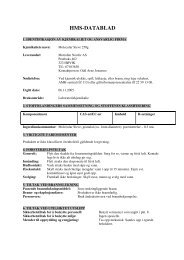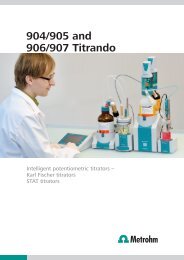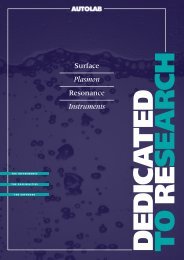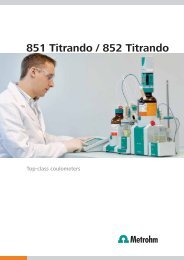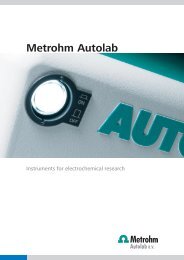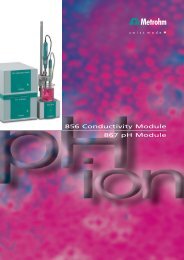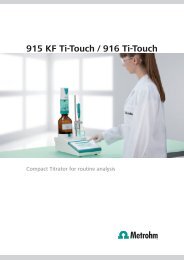General Catalog
General Catalog
General Catalog
Create successful ePaper yourself
Turn your PDF publications into a flip-book with our unique Google optimized e-Paper software.
Professional IC Systems<br />
Metrohm Inline Ultrafiltration and Dialysis<br />
Metrohm Inline Ultrafiltration<br />
Modern ion chromatography recommends all samples<br />
to be filtered prior to injection. Separation columns<br />
with particle sizes below 10 µm require absolutely<br />
particle-free sample solutions. Unfiltered solutions<br />
can increase pressure on the column which in some<br />
cases can radically reduce the life span of the column.<br />
Manual filtration is usually carried out by means of<br />
disposable filter cartridges with a pore size of 0.45 µm<br />
or less. These become clogged very quickly, particularly<br />
with samples containing very fine particles. Sample<br />
changers with filter caps are used as an alternative.<br />
Their pore size is often larger than that of disposable<br />
filters. However, they are expensive and there is still a<br />
risk of clogging.<br />
With Metrohm Inline Ultrafiltration, which belongs to<br />
the membrane separation techniques, these problems<br />
no longer apply. The samples are placed directly on<br />
the sample rack. When the samples are processed the<br />
sample flow is channelled into the lower chamber of<br />
the ultrafiltration cell and passes along the membrane<br />
and into the waste container. In the upper chamber of<br />
the cell a peristaltic pump creates a vacuum and draws<br />
the sample solution through the ultrafiltration membrane.<br />
The filtered sample solution enters the injection<br />
loop and is then injected. Less than 20% of the original<br />
solution is removed as filtrate, the remainder<br />
flows directly into the waste container. This, together<br />
with the geometrical arrangement of the cell, virtually<br />
eliminates the formation of a filter cake which could<br />
block the membrane. Metrohm Inline Ultrafiltration is<br />
particularly suitable for samples with a light to medium<br />
load, for example drinking water, surface water, wastewater,<br />
digestion solutions, extracts.<br />
Metrohm Inline Dialysis<br />
Highly polluted samples require complex and laborious<br />
sample preparation steps before they can be analyzed.<br />
Metrohm Inline Dialysis provides a considerable rationalization<br />
of the whole process. Samples must meet<br />
just one condition: they must be liquid or be able to be<br />
brought into liquid form and they need to be largely<br />
homogeneous. Larger particles can be removed by<br />
centrifuging, if necessary. The sample solution is then<br />
dialyzed in the dialysis cell according to the method<br />
patented by Metrohm (European Patent 0 820 804, US<br />
Patent 5,861,097). Due to this special «Inline Stopped-<br />
Flow Dialysis» method a virtually complete dialysis is<br />
obtained. This means that the acceptor solution has<br />
the same ionic concentration as the original sample<br />
(equilibrium dialysis). The acceptor solution is then<br />
injected directly into the ion chromatograph where it<br />
is analyzed. Whereas in ultrafiltration the sample solution<br />
is filtered through the membrane as a result of a<br />
difference in pressure, the driving force in dialysis is the<br />
difference in concentration between the two sides. The<br />
ions to be determined diffuse through the membrane,<br />
but no sample solution is forced through the membrane.<br />
This means that no filter cake is formed that could<br />
block the membrane. By means of this technique it<br />
is possible to determine anions and cations even in<br />
cutting oil emulsions, biodiesel, dairy products or body<br />
fluids such as blood and urine.<br />
If the system is programmed so that the next sample is<br />
dialyzed during the current run, the total analysis takes<br />
about the same time as direct injection.<br />
Acceptor solution<br />
Sample<br />
Particle<br />
Membrane<br />
Ion<br />
Membrane<br />
Ion<br />
Particle<br />
Sample<br />
«Stopped flow» method<br />
An equilibrium is achieved between the acceptor solution and the sample<br />
solution<br />
Ultrafiltration<br />
14 — IC




